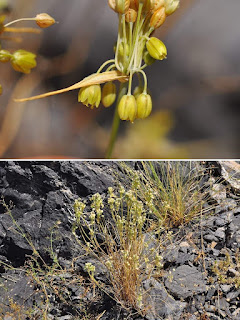[Most Recent Entries] [Calendar View]
Sunday, February 16th, 2025
| Time | Event | ||
| 4:00p | [Botany • 2022] Allium ayhan-toprakii (Amaryllidaceae) • A New Species of Allium sect. Codonoprasum from western Anatolia, Turkey
Allium ayhan-toprakii Yıldırım (Amaryllidaceae) is described as a new species from Mt. Sandras, Muğla Province, western Anatolia, Turkey. Based on morphological features, it belongs in Allium subgen. Allium sect. Codonoprasum. It is similar to A. carium and A. flavum subsp. tauricum var. Pilosum, but differs from them in several morphological characters, such as its flexous stem, stem length, indumentum, pedicel length, perigone length and colour, and ovary shape. Allium ayhan-toprakii Yıldırım Tuğkan Özdöl, Seval Erdem, and Hasan Yıldırım. 2022. Allium ayhan-toprakii (Amaryllidaceae), A New Species from Turkey. Annales Botanici Fennici. 59(1); 233-237. DOI: doi.org/10.5735/085.059.0134 | ||
| 4:03p | [Botany • 2024] Bulbophyllum bonjolianum (Orchidaceae: Epidendroideae: Bulbophyllinae) • A New Species of section Macrocaulia from Sumatra, Indonesia
Bulbophyllum bonjolianum Yudistira, Candra & Mustaqim, a member of section Macrocaulia, is described here based on a specimen collected from the mountains of West Sumatra. It is similar to B. tristriatum Carr. and B. pyridion J.J.Verm. but differs in the morphology of the dorsal sepal, petal and labellum. A key to B. bonjolianum and morphologically similar species is presented. Keywords. Endemic, epiphyte, Malesia, orchids, taxonomy Bulbophyllum bonjolianum Yudistira, Candra & Mustaqim, sp. nov. Bulbophyllum bonjolianum is morphologically similar to B. tristriatum Carr. and B. pyridion J.J.Verm., but differs in the dorsal sepals abruptly tapering from the middle upwards (vs gradually narrowing), pentagonal petal (vs elliptic-(ob)-ovate in B. tristriatum and elliptic in B. pyridion), and longer labellum (6.8–7 mm vs 3.5–5 mm in B. tristriatum and c. 3.2 mm long in B. pyridion) with the proximal adaxial surface coarsely papillose (vs smooth). The species is also similar to the Peninsular Malaysian species B. hodgsonii M.R.Hend., but the new species differs in its dorsal sepals abruptly tapering from the middle upwards (vs gradually narrowing), lateral sepals with 3 veins (vs 5), and the coarsely papillose adaxial surface of the labellum in the lower proximal part (vs smooth). Etymology. The species is named in honour of Tuanku Imam Bonjol, a national hero of Indonesia from West Sumatra Province. Yudistira, Y.R., Candra, R. and Mustaqim, W.A. 2024. A New Species of Bulbophyllum (Orchidaceae: Bulbophyllinae) section Macrocaulia from Sumatra, Indonesia. Gardens' Bulletin Singapore. 76(1); 251 - 258. | ||
| 4:03p | [Botany • 2024] Allium ahmet-tirasii (Amaryllidaceae) • A New Species of Allium sect. Scorodon from Southern Anatolia (Türkiye)
Abstract Allium ahmet-tirasii Yıldırım (Amaryllidaceae) is described as a new species from Alanya district in Antalya province, southern Türkiye. Diagnostic characteristics, a full description, and comprehensive illustrations are provided. Based on morphological features, it belongs to the Allium subgen. Polyprason sect. Scorodon. Allium ahmet-tirasii has no closely related species. It slightly resembles A. sivasicum, by the pale brownish-orange inner tunic and greenish-yellow perigone and A. opacum, by perigone size and color also style length. However, it is easily distinguished from both A. sivasicum and A. opacum by many other morphological characters and its habitat. It is characterized by 1–2 equal bulblets; spathe one or sometimes 2-valved, if with 2-valved, valves unilateral; filaments equal or slightly shorter than tepals; style 1.5–2 mm long before fertilization shorter than perigone. Monocots, Allium, Scorodon, new species, Türkiye Allium ahmet-tirasii Yıldırım sp. nova Eponymy:—This species is named after Mr. Ahmet Tıraş, an amateur botanist who collected the first specimen of the new species. The Turkish name of this species is suggested as “Alanya soğanı” according to the guidelines of Menemen et al. (2016). Hasan YILDIRIM, Tuğkan ÖZDÖL and Seval ERDEM. 2024. Allium ahmet-tirasii (Amaryllidaceae), A New Species from Southern Anatolia (Türkiye). Phytotaxa. 644(2); 102-112. DOI: doi.org/10.11646/phytotaxa.644.2.2 [2024-04-11] | ||
| 4:03p | [Botany • 2023] Allium beypazariense (Amaryllidaceae) • A New Species of Allium sect. Codonoprasum from middle Anatolia (Türkiye)
Abstract Allium beypazariense, a newly discovered species from the A. section Codonoprasum, is described and illustrated in this study. The species is endemic to middle Anatolia, Beypazarı and Çayırhan districts in Ankara in Türkiye. This research provides a comprehensive examination of the species, including its morphology, phenology, leaf anatomy, seed testa micromorphology, and conservation status. A comprehensive description of this species is provided, including detailed photographs and illustration, geographical distribution map, habitat and ecology. Furthermore, the taxonomic relationships between Allium beypazariense and its closest relatives, A. opacum is thoroughly explored and discussed. The new species can be easily distinguished from the close species by its mucronate tepal apex, sessile ovary, different anther colour, and thick scape. Anatolia, endemic, Sect. Codonoprasum, leaf anatomy, taxonomy, seed micromorphology, Monocots Allium beypazariense Koçyiğit, Özhatay & E.Kaya, sp. nov. Etymology:—The name of the species is derived from Beypazarı District. Beypazarı is a district of Ankara, Türkiye, and is the region where the new species was discovered for the first time. Mine KOÇYİĞİT, Zeynep Büşra ERARSLAN, Neriman ÖZHATAY and Erdal KAYA. 2023. Allium beypazariense (Amaryllidaceae), A New Species from middle Anatolia (Türkiye). Phytotaxa. 630(1); 51-60. DOI: doi.org/10.11646/phytotaxa.630.1.4 [2023-12-12] |
| << Previous Day |
2025/02/16 [Calendar] |
Next Day >> |














